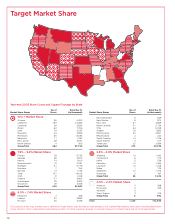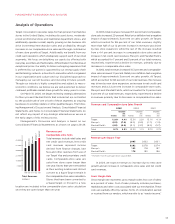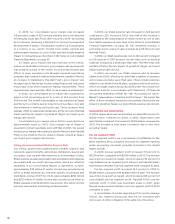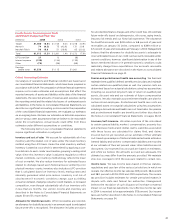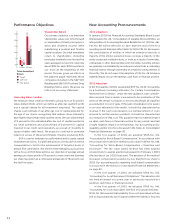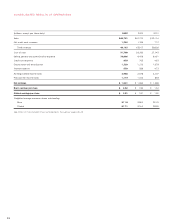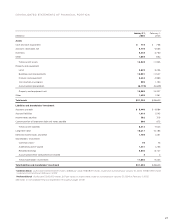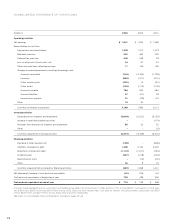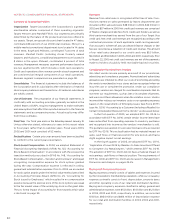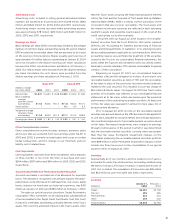Target 2003 Annual Report Download - page 23
Download and view the complete annual report
Please find page 23 of the 2003 Target annual report below. You can navigate through the pages in the report by either clicking on the pages listed below, or by using the keyword search tool below to find specific information within the annual report.
21
Fourth Quarter Pre-tax Segment Profit
and Percent Change from Prior Year
(millions) 2003 2002 2001
Target $1,380 18.5% $1,165 8.0% $1,078 20.9%
Mervyn’s 74 (0.3) 75 (42.9) 131 20.8
Marshall Field’s 59 15.6 51 (18.9) 63 (20.2)
Total $1,513 17.3% $1,291 1.4% $1,272 17.9%
LIFO provision 27 12 (8)
Interest expense (130) (154) (135)
Other (72) (36) (68)
Earnings
before taxes $1,338 $1,113 $1,061
Critical Accounting Estimates
Our analysis of operations and financial condition are based upon
our consolidated financial statements, which have been prepared in
accordance with GAAP. The preparation of these financial statements
requires us to make estimates and assumptions that affect the
reported amounts of assets and liabilities at the date of the financial
statements, the reported amounts of revenues and expenses during
the reporting period and the related disclosures of contingent assets
and liabilities. In the Notes to Consolidated Financial Statements, we
describe our significant accounting policies used in the preparation
of the consolidated financial statements. We evaluate our estimates
on an ongoing basis. We base our estimates on historical experience
and on various other assumptions that we believe to be reasonable
under the circumstances. Actual results could differ from these
estimates under different assumptions or conditions.
The following items in our consolidated financial statements
require significant estimation or judgment:
Inventory and cost of sales We account for substantially all of our
inventory and the related cost of sales under the retail inventory
method using the LIFO basis. Under the retail inventory method,
inventory is stated at cost, which is determined by applying a cost-
to-retail ratio to each similar merchandise grouping’s ending retail
value. Since this inventory value is adjusted regularly to reflect
market conditions, our inventory methodology reflects the lower
of cost or market. We also reduce inventory for estimated losses
related to shortage, based upon historical losses verified by prior
physical inventory counts. Inventory also includes a LIFO provision
that is calculated based on inventory levels, markup rates and
internally generated retail price indices. Inventory is at risk of
obsolescence if economic conditions change, such as shifting
consumer demand, changing consumer credit markets, or increased
competition, even though substantially all of our inventory sells
in less than six months. Our vendor income and inventory are
described in the Notes to Consolidated Financial Statements on
pages 30 and 31, respectively.
Allowance for doubtful accounts When receivables are recorded,
an allowance for doubtful accounts in an amount equal to anticipated
future write-offs is recognized. The allowance includes provisions
for uncollectible finance charges and other credit fees. We estimate
future write-offs based on delinquencies, risk scores, aging trends,
industry risk trends and our historical experience. The allowance
for doubtful accounts was $419 million or 6.8 percent of year-end
receivables at January 31, 2004, compared to $399 million or
6.7 percent of year-end receivables at February 1, 2003. Management
believes that the allowance for doubtful accounts is adequate to
cover anticipated losses in our credit card accounts receivable under
current conditions; however, significant deterioration in any of the
factors mentioned above or in general economic conditions could
materially change these expectations. Our accounts receivable
and related allowance are described in the Notes to Consolidated
Financial Statements on page 31.
Pension and postretirement health care accounting We fund and
maintain three qualified defined benefit pension plans and maintain
certain related non-qualified plans as well. Our pension costs are
determined based on actuarial calculations using key assumptions
including our expected long-term rate of return on qualified plan
assets, discount rate and our estimate of future compensation
increases. We also maintain a postretirement health care plan for
certain retired employees. Postretirement health care costs are
calculated based on actuarial calculations using key assumptions
including a discount rate and health care cost trend rates. Our pension
and postretirement health care benefits are further described in
the Notes to Consolidated Financial Statements on pages 36-37.
Insurance/self-insurance We retain a portion of the risk related
to certain general liability, workers’ compensation, property loss
and employee medical and dental claims. Liabilities associated
with these losses are calculated for claims filed, and claims
incurred but not yet reported, at our estimate of their ultimate
cost, based upon analysis of historical data and actuarial estimates.
General liability and workers’ compensation liabilities are recorded
at our estimate of their net present value; other liabilities are not
discounted. Our expected loss accruals are based on estimates,
and while we believe the amounts accrued are adequate, the
ultimate loss may differ from the amounts provided. We maintain
stop-loss coverage to limit the exposure related to certain risks.
Income taxes We pay income taxes based on the tax statutes,
regulations and case law of the various jurisdictions in which we
operate. Our effective income tax rate was 37.8 percent, 38.2 percent
and 38.0 percent in 2003, 2002 and 2001, respectively. The income
tax provision includes estimates for certain unresolved matters in
dispute with state and federal tax authorities. Management
believes the resolution of such disputes will not have a material
impact on our financial statements. Our effective income tax rate
in 2004 is expected to be approximately 37.8 percent. Our income
taxes are further described in the Notes to Consolidated Financial
Statements on page 34.







